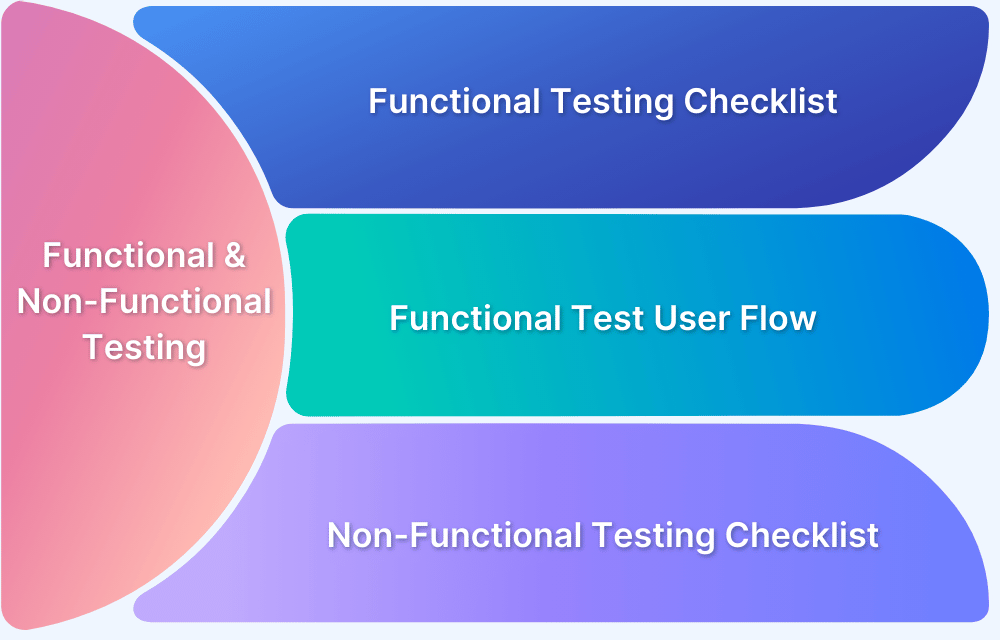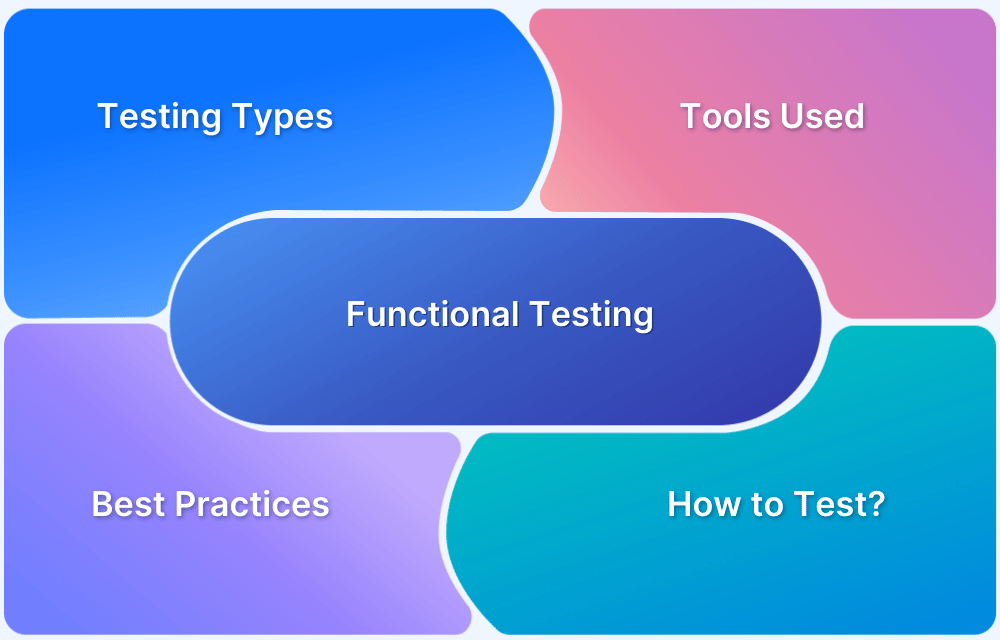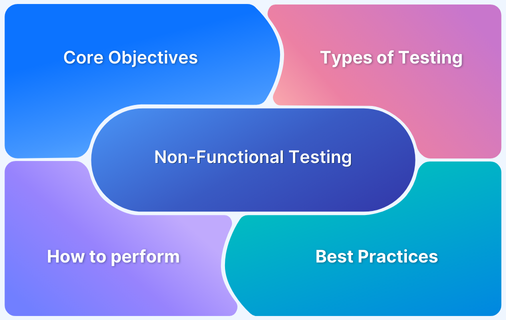Differences Between Functional and Non Functional Testing
By Shreya Bose, Community Contributor - September 16, 2024
In software testing, understanding the distinction between functional and non-functional testing is crucial to ensure both the functionality and overall performance of an application.
Functional testing focuses on validating that the software behaves according to the specified requirements and performs its intended tasks correctly. It checks features like input validation, user interface operations, and database interactions.
On the other hand, non-functional testing examines the performance, security, usability, and scalability of the software, ensuring that it meets quality standards beyond just functionality.
While functional testing answers “what” the system does, non-functional testing addresses “how” the system performs under various conditions. Both are essential for delivering a robust and reliable product.
What is Functional Testing?
Functional Testing verifies that a software application performs its intended functions correctly according to specified requirements. It focuses on testing user interactions, features, and outputs to ensure proper functionality.
Functional Testing is a sub-set of software testing in which the QA/tester tries to verify that the software works (“functions”) is accordance with technical, business and customer requirements. It is a form of black-bos testing in which each function of the website/app is checked so that it aligns with corresponding requirements (from the brainstorming and planning stages).
Functional tests are run by designing and feeding specific user input data, monitoring the system’s output in response to this data, and comparing the actual results with expected ones.
A few common examples of the kind of “function” that a functional test verifies:
- Can users easily and seamless log into the site/app with the correct credentials?
- When a user clicks “Buy Now”, does the UI take them directly to the next required page?
- If a user enters special characters in a field where they are not allowed, does the system throw up an error message and refuse to proceed?
If you need more clarify, don’t worry. We’ll discuss the differences between functional and non functional testing later in this piece.
Scope of Functional Testing
- Testing every function to verify if each one does what it is meant to, especially in the light of business and technical requirements.
- Investigating that an application correctly works with each set of business logic specifications to provide expected output.
- Comprises positive, happy path tests AND tests to ensure that the application acts differently (and accordingly) in non-ideal conditions to keep functioning.
Read More: Debunking Myths about Functional Testing
Types of Functional Testing
1. Unit Testing:
- Developers create and run unit tests for individual code blocks before integration into the larger codebase.
- Each unit test focuses on verifying a single, isolated component.
- It is the most granular level of testing in the Software Development Life Cycle (SDLC).
- Serves as the foundation for broader, layered tests conducted later in the process.
2. Component Testing
- Component Testing Isolates and tests a single software module for bugs.
- More complex scripts are required compared to unit tests.
- Verifies the interaction between multiple units within a single component.
3. Integration testing
- After components are verified, they are integrated and tested for collective functionality.
- Integration Testing is crucial since different modules are often developed by different team members.
- Microservices, a common design in modern software, require thorough testing of their interactions as part of integration tests.
4. System testing
- Tests the software as a fully integrated system to ensure it meets all stakeholder requirements.
- Also known as End-to-End (E2E) Testing.
- Requires a test environment that simulates real user conditions.
- Verifies the software’s readiness for use by real customers.
5. Regression Testing
- Regression Testing ensures that changes to the software do not interfere with existing features or functionality.
- Triggered after every alteration to verify stability and efficiency.
- Aims to maintain the overall integrity of the software throughout development.
6. Sanity Testing
- Sanity testing verifies the stability of a build after bug fixes or new code additions.
- Similar to regression testing but focuses only on the changed or fixed areas.
- Ensures the recent changes haven’t broken key functionality before further testing.
7. Smoke Testing
- Smoke Testing is performed by QA after the build is completed to test critical functions.
- Acts as the final layer of testing before User Acceptance Testing (UAT) and the production release cycle.
- Ensures the software’s basic functionality is intact before further testing or release.
Read More: Sanity Testing vs Smoke Testing
Example of a Functional Test
- A healthcare app wants to add home delivery of medicines to its app. One of the features is an “Add to Cart” button. A unit test will be run to verify the individual button’s validity.
- The app wants to show users nearby healthcare centers based on their GPS data. Verifying this function requires a module test, as it requires multiple units to work together to get the expected result.
- The app offers users the ability to directly transfer money from their bank account to the app’s own “wallet” for faster purchases. At this point, two modules come into play and tests must be run to check how well they integrate to get the job done. Cue the integration tests.
What is Non Functional Testing?
Non Functional Testing assesses the performance, usability, and other attributes of a software application beyond its core functions. It ensures the software meets quality standards like speed, security, and scalability.
As the name suggests, non-functional testing covers non-functions attributes of any software. It tests everything not already verified by functional tests.
These non-functional software elements include performance, usability, stability, efficiency, maintainability, and portability, though non-functional tests can include some aspects if the project requires it. Like functional tests, this form of QA verification also uses SRS (Software Requirements Specification) documents to create test scenarios, suites, and scripts.
Its final goal is to optimize all non-functional elements so that the software under test can offer the best possible user experience.
Scope of Non Functional Testing
- Identifying gaps in product usability, maintainability, effectiveness, stability and portability.
- Reducing the risk of bugs (and consequently user disapproval and monetary loss) emerging in production when software is actually used by end-users.
- To simplify and debug mechanisms related to installation, configuration, management and monitoring the software.
- Identifying (based on expected real-world usage) the metrics that must be tracked and studied to gauge product success.
- Creating or adding to the repository of knowledge (internal or open-source) about the specific product and the larger technology that powers it.
Types of Non Functional Testing
1. Performance Testing
- Assesses whether software performs at optimal levels.
- Key markers include page/app loading speed, crash rates, memory usage, latency time, throughput, and CPU interrupts per second.
Pro Tip: Use BrowserStack App Automate for automated performance testing of mobile apps and SpeedLab to analyze and optimize page load speed for enhanced web performance.
2. Load Testing
- Evaluates how a system manages increased load, such as simultaneous user logins and transactions.
- Assesses performance under stress to ensure stability and scalability.
3. Security Testing
- Identifies weaknesses and vulnerabilities in the software from a hacker’s perspective.
- Scans system design for gaps that could be exploited for data theft or unauthorized changes.
4. Visual Testing
- Checks if UI elements render correctly, verifying shape, size, color, font, and placement.
- Ensures the software’s visual output matches the expected requirements.
Pro Tip: Use Percy and App Percy by BrowserStack for automated visual testing to efficiently catch UI discrepancies across web and mobile applications, ensuring consistent and accurate visual output.
5. Stress Testing
- Assesses how a system behaves under extreme conditions or overloads.
- Identifies breaking points and measures how well the system recovers from failures.
6. Scalability Testing
- Evaluates how well a system can handle increased load or growing data volumes.
- Determines the system’s ability to scale up or out while maintaining performance and stability.
7. Responsive Testing
- Evaluates if an app/site displays correctly across various screen sizes and resolutions.
- Ensures optimal performance on mobile devices, tablets, and desktops.
- Essential for user satisfaction as most users access the internet from mobile devices.
Pro Tip: Leverage BrowserStack’s Responsive Testing to effortlessly test and ensure your website’s compatibility across a wide range of devices and screen sizes. This helps guarantee a seamless user experience on mobile, tablet, and desktop platforms, enhancing overall accessibility and performance.
Ideal tools for responsive tests: BrowserStack Live and BrowserStack Responsive Design Tester (free tool).
Examples of Non-Functional Tests
- An eCommerce app must be optimized to handle heavy user traffic for the upcoming Black Friday. Load tests, recovery tests, and volume tests must be run to ensure that it does not buckle and bend under a wildly increased inflow of users.
- Your software has been released, and a week after, so has the new iPhone. Responsive tests and portability tests are required to ensure that it is rendering well on the new iPhone’s screen, and is compatible with the iOS version the phone is running on.
- Your website homepage has a big green button with CTA text on it. Visual tests are needed to check if the button shows up clearly, unobstructed, and center screen on different browsers, devices, and OSes.
Difference between Functional and Non Functional Testing
While Functional testing verifies that a software application performs its intended functions correctly, focusing on features and interactions, on the other hand, Non-functional testing assesses overall performance, usability, and quality attributes like speed and security.
While functional testing ensures feature correctness, non-functional testing guarantees broader standards of reliability and user experience.
| Parameters | Functional Testing | Non-Functional Testing |
|---|---|---|
| Focus | Validates specific functionalities of the software. | Assesses performance, usability, and other quality attributes. |
| Purpose | Ensures the software performs its intended functions. | Ensures the software meets performance, security, and usability standards. |
| Scope | Tests individual functions or features in isolation. | Tests overall system behavior and quality attributes. |
| Examples | Input validation, business logic, and user interactions. | Performance, load, security, and usability testing. |
| Testing Type | Generally includes unit, integration, and system testing. | Includes stress, scalability, and reliability testing. |
| Metrics | Measures correctness of output and feature functionality. | Measures speed, stability, and user experience. |
| Execution | Often automated and performed during development phases. | Often involves specialized tools and may require specific environments. |
| Outcome | Confirms that the software meets specified functional requirements. | Ensures the software can handle expected and unexpected conditions effectively. |
Conclusion
In conclusion, both functional and non-functional testing play vital roles in ensuring software quality. While functional testing verifies that each feature operates correctly according to specifications, non-functional testing assesses the software’s performance, security, and usability under various conditions.
A comprehensive testing strategy that includes both approaches is essential for delivering a reliable, high-performing application that meets both user expectations and business requirements. By understanding and applying these testing methodologies, developers and QA teams can address both the functional and operational aspects of software, ultimately leading to a more robust and user-friendly product.
For effective functional testing, BrowserStack offers two powerful tools: BrowserStack Live and BrowserStack Automate. BrowserStack Live enables real-time manual testing on a wide range of real devices and browsers, allowing you to verify user interactions and interface elements in various environments.
BrowserStack Automate provides scalable automated testing across multiple platforms, running extensive test suites without manual intervention. Together, these tools ensure comprehensive functional validation, helping you deliver a seamless and high-quality user experience across different devices and browsers.
BrowserStack Percy simplifies non-functional testing by automating visual tests across web and mobile apps. It captures and compares screenshots to detect UI discrepancies, ensuring visual consistency and performance across devices and browsers. Integrate Percy to maintain your software’s visual integrity and enhance user experience efficiently.





